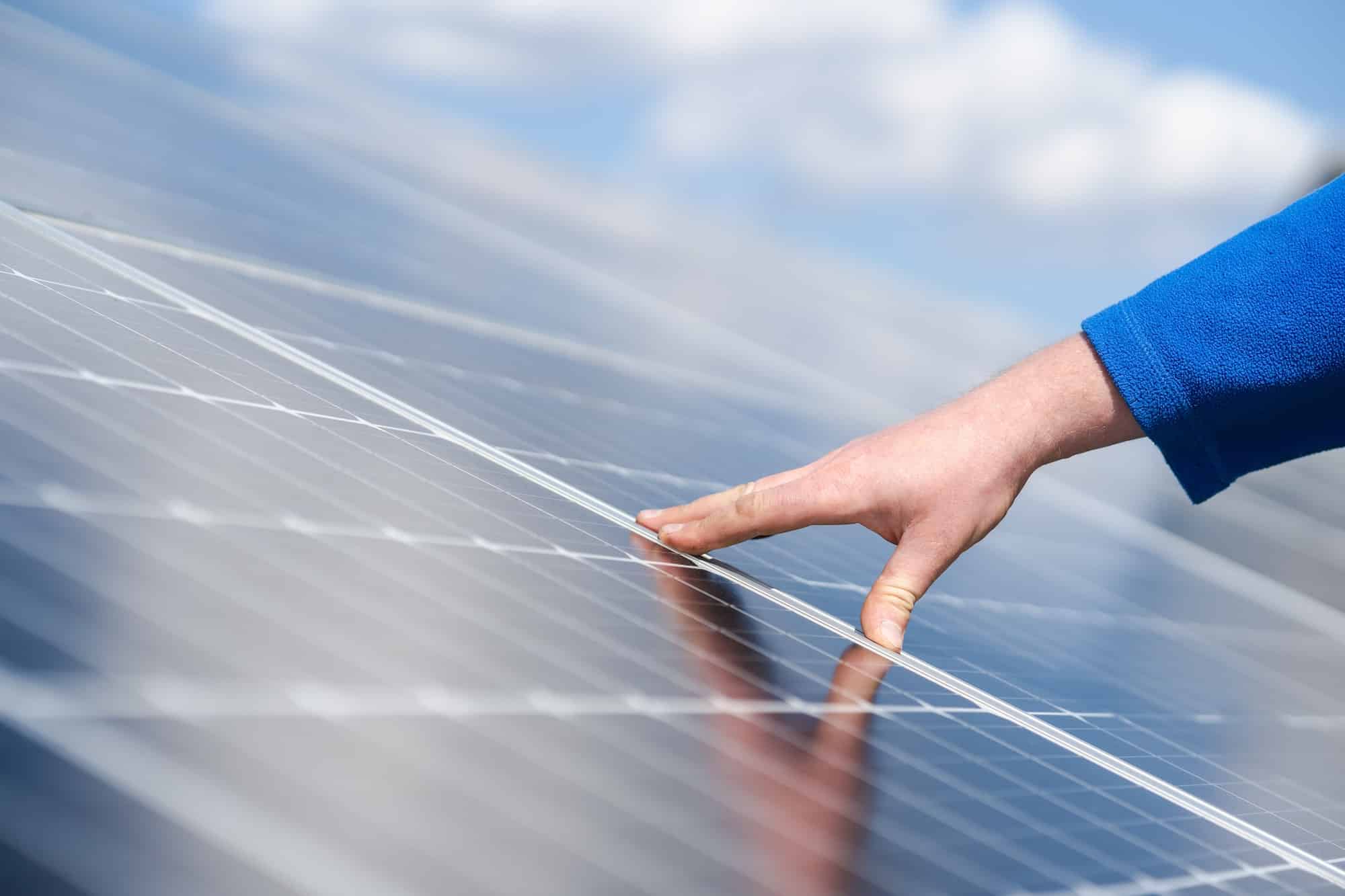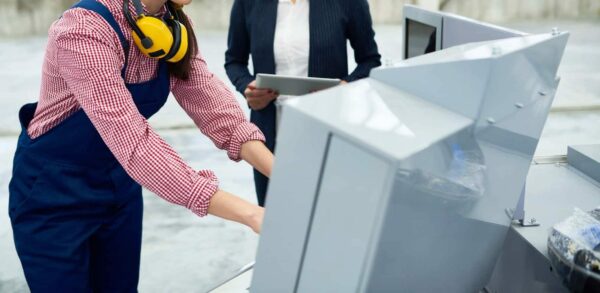With solar technology at its peak, solar energy has become increasingly popular in many commercial applications. Depending on where you live, you may encounter office buildings, industrial buildings, and even parking lots covered by commercial solar panels. As a business owner, property owner, or contractor, you can take advantage of many benefits by installing this clean energy solution on your property.
If you’re interested in learning more about the benefits of installing solar panels at your property, our team is standing by to answer any questions you have about commercial solar power, including costs, applications, insurance considerations, benefits, and incentives.

Factors That Affect Solar Panel Cost
Although renewable energy systems like solar photovoltaic panels may introduce new money-saving opportunities, the upfront costs are challenging to estimate. There isn’t a one-size-fits-all approach to determining the cost of solar panels.
Several factors affect installation costs, including:
- System Size
- Type of Equipment
- Energy Demands
- Solar Panel Location
- Solar Panel Unit Brand
Size of the Unit
Each installation requires a custom-designed system to fill the building’s size and energy needs. As you can imagine, larger systems typically cost more to install. To estimate the cost of your commercial solar installation, consider the following questions:
How Many Solar Panels Will I Need?
The overall size will have a significant impact on the installation cost. For example, a small clinic or retail store will not need the same energy supply as a large factory or commercial farm. In simple terms, by dividing how many kWh a single solar panel can generate by how much energy your business uses, you can figure out how many solar panels your building will need.
We recommend calling a professional to come out and calculate the correct amount of panels so your business can benefit from the maximum amount of solar energy possible.
What Type of Mounting Infrastructure Will I Need?
Installers use different mounting infrastructures depending on the project’s location and budget. You may opt to mount panels on a pitched roof, a flat roof, on the ground, over a parking lot, or on other mounting equipment. Where you put your solar panels may dictate the type of racking you need.
Solar panels come in two basic types:
- Fixed solar panels remain stable regardless of the sun’s movement. Installers place fixed panels at the ideal angle for absorbing as much sunlight throughout the day as possible.
- Responsive solar panels move throughout the day, aligning with the sun to best catch its rays. Responsive solar panels may move along one or two axes depending on the complexity of the mounting infrastructure.
Fixed panels generally cost less than responsive mounts because the latter requires more complicated infrastructure and powered racking.
What Percentage of My Energy Usage Will Come From Solar?
Your intention will also affect the cost of your commercial solar panels. Will you rely on your solar panel as your primary energy source, or will you use it to offset the costs of pulling energy from the grid?
On average, commercial solar arrays, or a string of connected panels, provide commercial and industrial buildings with 75% of their energy.
What Is the Current Energy-Efficiency State of My Building?
If your building lacks energy efficiency, you’ll need more power and a more extensive solar panel system than a building with better efficiency. To reduce the costs of your solar panel installation, ensure that your facility is equipped with energy-efficient features. Upgrading your building with energy-efficient features will lower the energy solar panels need to generate.
Type of Equipment
Solar panel prices vary depending on their efficiency and other factors. Highly efficient panels cost more upfront but will provide more energy using fewer panels.
Other equipment considerations include the panel mounts. The cost of the equipment you’ll need for installation depends on where and how you want to mount the panels. For example, ground-mounted systems need underground cabling to connect them to the building’s meter, which increases overall costs.
Let’s review the most common mounting locations for solar panels—and the equipment involved:
Rooftop Solar
Many commercial and industrial solar arrays use rooftop mounting to take advantage of unused space and direct sunlight exposure. Your system may use a traditional roof-mounted system, which uses rails to anchor panels on sloped surfaces. Installers also use single-tilt and dual-tilt mounts for flat-roof installations.
Carport Solar
Many commercial properties like retail outlets and department stores take advantage of the large spaces above parking lots by installing solar carport solutions. These innovative solar arrays get installed on various canopies that simultaneously collect solar energy and provide shade for the vehicles parked beneath them.
Common canopy types include long-span canopies that cover two parking rows and the driving lane between them and dual-tilt canopies that cover single parking rows.
Ground Solutions
Some commercial and industrial properties have the space for large solar panel systems mounted at ground level. These systems use mounting racks that place the panels at an optimal angle for collecting peak rays of sunlight. Many ground solutions use responsive arrays that track the sun for optimal energy absorption.
Electricity Demands
The more electricity your building needs, the higher the costs of installing commercial solar panels. For example, consider how these national average prices vary depending on the wattage requirements:
- A 15 kW system for a retail store costs around $22,000
- A 75 kW system for a warehouse costs around $109,000
- A 350 kW system for a hospital costs around $508,000
We offer these prices as examples. They may not accurately reflect the cost of installation in your area.
Solar Power Location
Location is one of the most important considerations before installing commercial solar panels. The reasons for this will range from the amount of sun your property gets to market factors in your area, so let’s look at each more closely:
Sunshine Availability
The amount of sunlight in your region will directly impact installation costs because the fewer hours of peak sunlight you get, the more panels you’ll need to meet your energy needs.
Suppose your building enjoys sunshine for long hours each day and more than half the year. You’ll require far fewer panels to produce enough energy than a facility in an area prone to long stretches of cloud cover and minimal sunny days.
Federal, State, and Local Incentives
Your solar installation costs may decrease thanks to federal tax credits and other incentives. We recommend researching the commercial solar benefits your local and state governments and utility companies offer. By doing some research, you can take advantage of all available rebates, tax credits, and other incentives.
Market Factors
As with any other industry, market factors can hike or reduce the price of solar panel installation. Relevant market factors include:
- Market competition
- The number of available jobs
- Supply chains
- Labor costs
- PV panel costs
- Structural and electrical costs
- Design costs
- Engineering costs
- Permit costs
Markets fluctuate throughout the year. Keeping an eye on the market can help you get in when costs are cheaper.
Solar Panel Unit Brand
Many solar panel brands offer high-quality units, but some charge higher prices than others based on popularity. Finding an affordable option means balancing the quality of the equipment with the brand’s trustworthiness. The most popular brand may not necessarily offer the best quality or affordability.
The cost of installing a commercial solar energy system may seem steep, but solar technology has become more affordable through the decades. Solar panel systems now cost more than one-third of what they did a decade ago.
Where Can Solar Panels Be Installed?
While you’ll predominantly find residential solar panels on roofs, commercial sites provide many other options regarding where installers can place solar panels. In addition to the roof of the property, solar panels can also be installed on:
- Empty Fields
- Facades
- Barns
- Sheds
- Parking lots
- Parking garages
- Gazebos
- Poles
- Ponds
- Lakes
Did we really include ponds and lakes on this list? You bet! Although only a few options exist in the U.S., installers worldwide have begun to offer floating solar panel solutions that sit atop calm bodies of water.
Average Solar Panel Costs
The costs of solar panels will vary depending on the state you’re located in, how much sun your home receives daily, and how large of a solar panel system you need. You can use an online solar panel calculator to get a general idea for how much your solar panels may cost, but your best bet is to speak with an installer directly. Here are some general estimates for the average cost of solar panel systems by size based on an average price of $3 per watt. The per-watt prices in your area may differ.
Small Commercial Solar Panel Costs
Small, 25-kW systems average around $50,000. Examples of small commercial applications include:
- Retail boutiques
- Small clinics
- Small offices
Small-Medium Commercial Solar Panel Cost
Small to medium-sized 50-kW systems may cost around $100,000. These applications include:
- Larger retail stores
- Medium-sized office buildings
Medium Commercial Solar Panel Cost
100-kW systems can cost around $200,000 to install. Applications may include:
- Commercial farms
- Warehouses
Large Commercial Solar Panel Cost
Large commercial systems at 250 kW may cost around $500,000. Commercial applications include:
- Schools
- Hospitals
- Factories
Extra-Large Commercial Solar Panel Cost
Extensive commercial systems of 300 kW or more can cost more than $1 million to install. Example applications of extra-large commercial solar panel systems include:
- Large shopping malls
- Industrial Factories and corporations
Commercial Solar Panel Insurance
Solar panels represent a considerable investment for any commercial or industrial business. Fortunately, there are a number of insurance policies that can be purchased specific to your solar panel investment.
Solar Property Insurance
Solar panel arrays must face the sky, making them vulnerable to severe weather and other disasters. Replacing damaged panels, infrastructure, cabling, and other elements may cost nearly as much as the initial installation without solar property insurance. Look into this insurance solution to protect your commercial solar panels from natural dangers like:
- Wind
- Hail
- Lightning
- Fire
- Earthquakes
General Liability Insurance
General liability insurance protects your enterprise from the financial burdens of injuries on your property. Most people consider this insurance “slip-and-fall” protection, but it can also cover you if a property visitor sustains an injury related to your solar energy system.
Your commercial solar system installer should be general liability insured to protect everyone from all sides.
Solar Surety Bonds
Solar surety bonds ensure that solar projects get done and that all contractors and sub-contractors receive payment for their work. Examples of solar surety bonds include:
- Performance bonds (EPCs) hold solar installers accountable for job completion.
- Community bonds provide low-interest financing to businesses installing renewable energy technology.
- Interconnection bonds ensure the proper maintenance of the solar system.
Benefits Of Converting Your Business To Solar Power
Aside from the clear positive environmental impact, switching over to solar power will reap many additional financial benefits for your business as well.
Solar Pays For Itself
Although commercial solar panels are expensive to install, companies and other organizations often recoup their investment within 10 years or so after calculating tax rebates, tax incentives, energy bill savings, and energy efficiency improvements. Since the typical lifespan of commercial solar panels is currently about 30 years, this means you would have roughly 20 years of “free energy” once your investment is recouped.
What’s more, in most states, the power company will buy any excess energy that your solar panels produce. Let’s say there have been a number of very sunny days in a row and your solar batteries are at max capacity. As your solar panels continue to capture more UV rays, the energy they create will automatically be sold back to the energy without any additional work required on your end.
Saving Money
One of the most attractive things about investing in solar energy is that your monthly energy bill will basically disappear. If you are financing the solar panels, you can think of your finance payment as a “replacement” for your energy bill, however, your monthly payments are essentially being reinvested into your property. If you were to purchase the solar panel system outright, you might never see another energy bill again.
Businesses that invest in solar energy benefit from regular savings on monthly energy bills. On average, commercial entities save about $1,400 per month on electricity and pay off their systems in three to seven years.
Installing commercial solar panels also results in higher property values. If you decide to sell your property, you’re sure to receive decent profits.
Tax Credits
The U.S. offers the federal investment tax credit (ITC) to companies installing solar panel systems.
Also called the solar tax credit, the ITC allows businesses to automatically recoup 26% (in 2022) of their installation costs when filing that year’s taxes. For example, if your commercial solar panels cost $100,000, you may recoup up to $26,000.
State and local governments may also provide tax credits for solar panel investments.
MACRS Depreciation
The U.S. uses the modified accelerated cost recovery system (MACRS). This tax depreciation system reduces tax liabilities for five years after a business purchases an asset like a solar power system. Business owners can take advantage of this system combined with federal tax credits to reduce costs and maximize deductions while paying off the solar panel’s initial installation cost.
Electric Bill Offsets
You can significantly reduce your electric bill and potentially earn money by generating solar power. Connecting your solar energy panels to the grid can make you money on what you add through net metering. Other effects of solar panels on electricity costs include:
- Safeguarding against electricity price hikes
- Increasing cash flow by reducing energy bills and earning money through net metering
- Producing free electricity (after the payback period)
The initial installation price may be steep, but the utility bill offsets that come with it quickly reduce the cost.
Foster a Sustainable Brand Image
Most modern consumers look for businesses using sustainable practices and green solutions when choosing between competing goods or services. When commercial entities invest in solar energy, they boost their reputations and customer loyalty by demonstrating care for the environment. Your choice to use a sustainable energy source may be just what you need to rise above the competition.
Support Local Economy
Many companies installing commercial solar panels live and work in your local economy. When you invest in installation from local businesses, you’re stimulating your local economy and providing more jobs in your area.
Solar Panel Incentives
Business owners who install commercial solar panels enjoy many incentives from the federal government and state and local incentives. These include:
Utility Rebates
Utility companies offer many incentives for photovoltaic (PV) systems, including rebates that can significantly reduce the cost of installation. Research rebate offers from utility providers in your area to determine if you could benefit from one of these rebates.
State and Local Incentives
Each state and local jurisdiction may offer its own incentives in hopes businesses choose a greener electricity option. Some offers may include:
- Loan guarantees
- Income tax credits
- Equipment exemptions for property taxes
- State and nonprofit grants
- Accelerated depreciation
- Depreciation bonuses
Check state and local governments to see what they offer and what your building may qualify for.
Net Metering
Some utility providers offer net metering incentives. Net metering comes into play when your solar system produces more energy than it uses and transfers that unused energy into the grid. Instead of paying the utility company for the energy you use, the utility pays you for the energy exported to the grid.
This incentive offers long-term energy cost savings and helps businesses repay installation loans more quickly.
Solar Investment Tax Credit
The most prominent tax credit comes from the federal government’s ITC. The federal government issues this credit to entities investing in solar energy. Expenses eligible for this tax credit include:
- Solar panels, mounts, inverters, charge controllers, and wiring
- Direct and indirect installation costs
- Transformers, surge protectors, and circuit breakers
- Batteries and other renewable energy storage equipment
We recommend doing extensive research to ensure you follow all installation protocols and requirements to maximize your tax credit.
Sales Tax Incentives
Some areas offer exemptions for sales taxes on initial installation costs for solar panels. The ITC also includes sales and use taxes under eligible expenses. Check with your local mandates to see if you’re eligible to get your solar panels installed with zero percent sale tax.
Get A Commercial Solar Panel Quote Today!
If you’re interested in learning more about installing commercial solar panels on your property, give Suncoast Power a call. Our team can assist with all of your commercial energy solutions including solar panel installation, backup generator installation, electrical maintenance, electrical upgrades and much more.
Get your commercial solar panel quote started by filling out our online contact form or calling us directly at 754-200-5872!


